ULTIMATE TOYOTA AXLE: PART 3 - Full floating conversion kit - Toyota Tacoma - April 2005 Toyota 4x4 @ Off-Road.com
Toyota Tacoma
ULTIMATE TOYOTA AXLE: PART
3
By Jesse Katz and Sean Estes
"Trails Less Traveled"
ULTIMATE TOYOTA AXLE: PART
3
Full Floating Conversion Kit
By Jesse Katz and Sean Estes"Trails Less Traveled"
|
|||||
| INTRODUCTION We started off this
series of articles by covering the fundamentals of differentials
and gearing. WFO Concepts assembled our non-TRD Tacoma/T100/Tundra
third member with an ARB air locker and Superior 5.29:1 ring and
pinion gears. We also toured the Superior facility with Mike
Denton, jr. and he showed us all of the steps involved in
manufacturing custom axles, like the 4340 full-floating axle-shafts
they built for us. This installment will focus on the features of
our new custom axle housing, built by
Diamond Axles and a full floating
conversion kit manufactured by Front Range Off
Road. Before we look at these products in detail,
let’s review the differences between semi-floating and
full-floating axles. SEMI-FLOATING AXLE 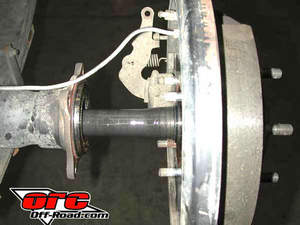 Most cars and trucks on the road with solid rear axles use semi-floating axle-shafts. In this simple and cost-effective design, the axle-shafts support the weight of the vehicle in addition to providing the driving force to the wheels/tires. Semi-floating axles just aren’t the best choice for any vehicle that carries heavy loads or is driven hard off-road. A slightly bent axle-shaft will cause the axle seals to fail prematurely, allowing oil to seep past the wheel bearings, contaminating the drum brakes and rendering them useless. A broken axle-shaft can result in more serious damage if the wheel/tire separates from the vehicle when the axle-shaft fails. FULL-FLOATING AXLE 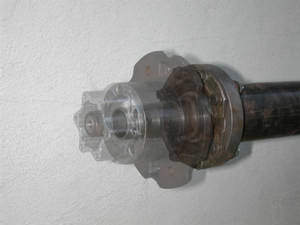 This transparent image of our full-floating assembly
is intended to illustrate the knee-bone-connected-to-the-shin-bone
relationship of the components in a typical
‘full-floater’ setup. The axle-shaft turns the
drive-flange (not pictured) that is bolted to the hub. The hub
rotates on the spindle, which is mounted to the axle-housing using
FROR’s adapter plate. The axle housing carries the vertical
load and the axle-shaft is only used to provide power to the
wheels. Full-floating axles use two sets of tapered wheel bearings
per wheel, mounted in tension, to distribute vertical and lateral
loads. Full-floating wheel-bearings are typically much larger in
diameter because they ride on the spindle instead of inside the
axle housing. In contrast, semi-floating axles use a single wheel
bearing per wheel, pressed onto the axle-shaft, and the whole
assembly is bolted into the axle housing together. For reference,
all steering 4WD front axles are ‘full-floaters’
because the wheel/hub has to ride on a spindle that is able to
turn/steer. Full-floating axles are superior to semi-floating
axles. It’s a better design, plain and simple. This transparent image of our full-floating assembly
is intended to illustrate the knee-bone-connected-to-the-shin-bone
relationship of the components in a typical
‘full-floater’ setup. The axle-shaft turns the
drive-flange (not pictured) that is bolted to the hub. The hub
rotates on the spindle, which is mounted to the axle-housing using
FROR’s adapter plate. The axle housing carries the vertical
load and the axle-shaft is only used to provide power to the
wheels. Full-floating axles use two sets of tapered wheel bearings
per wheel, mounted in tension, to distribute vertical and lateral
loads. Full-floating wheel-bearings are typically much larger in
diameter because they ride on the spindle instead of inside the
axle housing. In contrast, semi-floating axles use a single wheel
bearing per wheel, pressed onto the axle-shaft, and the whole
assembly is bolted into the axle housing together. For reference,
all steering 4WD front axles are ‘full-floaters’
because the wheel/hub has to ride on a spindle that is able to
turn/steer. Full-floating axles are superior to semi-floating
axles. It’s a better design, plain and simple.AXLE HOUSING 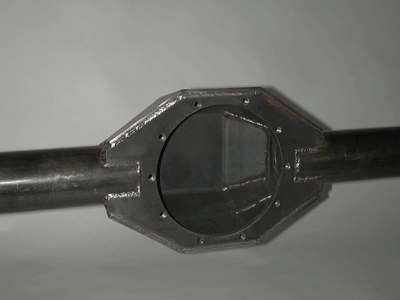 Diamond Axles recently introduced a
complete line of axle-housings designed specifically for off-road
use. These fabricated housings can be custom-made to accommodate
standard Toyota 8” center-sections, as well as TRD
electric-locking differentials and non-TRD Tacoma/T100/Tundra third
members. A heavy-duty Ford 9” version is also available. Diamond Axles recently introduced a
complete line of axle-housings designed specifically for off-road
use. These fabricated housings can be custom-made to accommodate
standard Toyota 8” center-sections, as well as TRD
electric-locking differentials and non-TRD Tacoma/T100/Tundra third
members. A heavy-duty Ford 9” version is also available.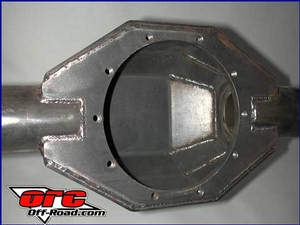 We decided to order a 66” wide non-TRD
Tacoma/T100/Tundra housing for our Ultimate Toyota-Based Rear Axle
Build-Up. A stock Tacoma’s rear axle width is 60”
(wheel-mounting-surface to wheel-mounting-surface), but we wanted
to match the track-width of a stock Tundra/T100’s rear axle
because our front axle width is 67” (the same width as a
Tundra front end). We decided to order a 66” wide non-TRD
Tacoma/T100/Tundra housing for our Ultimate Toyota-Based Rear Axle
Build-Up. A stock Tacoma’s rear axle width is 60”
(wheel-mounting-surface to wheel-mounting-surface), but we wanted
to match the track-width of a stock Tundra/T100’s rear axle
because our front axle width is 67” (the same width as a
Tundra front end). 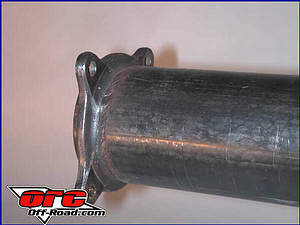 Stock Toyota axle housings DO bend frequently when
subjected to hard use off-road. The additional strength and custom
widths available from Diamond Axles made our decision to order a
new axle housing easier. Our new housing uses massive 3-1/2”
diameter DOM axle tubes with .375” wall thickness vs. the
stock Toyota housing at 3” diameter x approximately
.188” wall thickness. Ground clearance is also improved by
3/4” and is slightly more on some models. The new Diamond
Axle weighs in at about 80lbs, compared to 45lbs for a similar
width stock Toyota housing. Housings can be ordered with 3, 3-1/8
or 3-1/4” diameter tubing with any wall thickness to tailor
the strength/weight for specific applications. Stock Toyota axle housings DO bend frequently when
subjected to hard use off-road. The additional strength and custom
widths available from Diamond Axles made our decision to order a
new axle housing easier. Our new housing uses massive 3-1/2”
diameter DOM axle tubes with .375” wall thickness vs. the
stock Toyota housing at 3” diameter x approximately
.188” wall thickness. Ground clearance is also improved by
3/4” and is slightly more on some models. The new Diamond
Axle weighs in at about 80lbs, compared to 45lbs for a similar
width stock Toyota housing. Housings can be ordered with 3, 3-1/8
or 3-1/4” diameter tubing with any wall thickness to tailor
the strength/weight for specific applications.FULL FLOATING CONVERSION 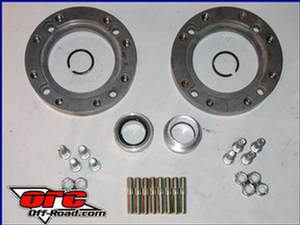 Front Range Off Road has developed a
bolt-on full-floater kit that fits all four-wheel drive Toyota rear
axles and upgrades the rear axle to disc brakes at the same time.
The kit consists of a set of custom full-floating axle-shafts,
machined steel spindle adapters with disc brake tabs and all
necessary hardware/seals. The kit is designed to maintain stock
track-width, so tire-to-body clearances will not be affected. If
you have any reservations about a ‘bolt-on’
full-floater kit, read on. We had some doubts too, until we talked
to Brian at FROR. He reminded us that bolt-on spindles have been
used on all types of front axles in exactly the same way without
incident. These Toyota front hubs and spindles are clearly stronger
than the stock Toyota semi-floating rear axles and the splines at
the drive flanges/locking hubs are 1.3” diameter x 30-spline,
just like the inner axle-shaft splines at the carrier. Front Range Off Road has developed a
bolt-on full-floater kit that fits all four-wheel drive Toyota rear
axles and upgrades the rear axle to disc brakes at the same time.
The kit consists of a set of custom full-floating axle-shafts,
machined steel spindle adapters with disc brake tabs and all
necessary hardware/seals. The kit is designed to maintain stock
track-width, so tire-to-body clearances will not be affected. If
you have any reservations about a ‘bolt-on’
full-floater kit, read on. We had some doubts too, until we talked
to Brian at FROR. He reminded us that bolt-on spindles have been
used on all types of front axles in exactly the same way without
incident. These Toyota front hubs and spindles are clearly stronger
than the stock Toyota semi-floating rear axles and the splines at
the drive flanges/locking hubs are 1.3” diameter x 30-spline,
just like the inner axle-shaft splines at the carrier.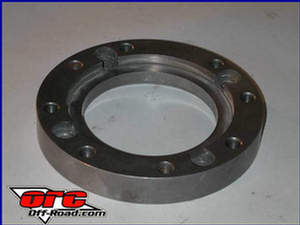 This
custom-machined adapter ring is the component at the center of the
FROR full-floater conversion. The adapter bolts to the axle housing
with the included studs and locknuts. There is a tolerance-fit
indexing ring machined into the adapter that mates to a male
register on the axle housing so that vertical loads are not
transferred to the mounting hardware. The hubs and spindles, as
well as the disc brake rotors and calipers, can be sourced from any
‘81-85 4x4 Toyota pickup. These parts are strong, reliable,
inexpensive and readily available. If you want to keep the
parking-brake, the rear calipers from a 79-81 Toyota Supra can also
be used with this kit. We are planning to adapt a pair of Tacoma
4-piston front disc calipers and rotors to our rear axle, so we
ordered it without any brake mounts. Larger Tundra rotors and
calipers will probably replace our stock front brakes to maintain
some brake bias. Any time the rear brakes are modified, a manual
proportioning valve (See “Removing LSPV” article)
should also be used in place of the factory LSPV (load sensing
proportioning valve). We ordered two complete hub and spindle
assemblies from Yota Yard in Denver, CO.
They’ve got the best selection and largest inventory of any
Toyota-specific truck wrecker we’ve ever used. This
custom-machined adapter ring is the component at the center of the
FROR full-floater conversion. The adapter bolts to the axle housing
with the included studs and locknuts. There is a tolerance-fit
indexing ring machined into the adapter that mates to a male
register on the axle housing so that vertical loads are not
transferred to the mounting hardware. The hubs and spindles, as
well as the disc brake rotors and calipers, can be sourced from any
‘81-85 4x4 Toyota pickup. These parts are strong, reliable,
inexpensive and readily available. If you want to keep the
parking-brake, the rear calipers from a 79-81 Toyota Supra can also
be used with this kit. We are planning to adapt a pair of Tacoma
4-piston front disc calipers and rotors to our rear axle, so we
ordered it without any brake mounts. Larger Tundra rotors and
calipers will probably replace our stock front brakes to maintain
some brake bias. Any time the rear brakes are modified, a manual
proportioning valve (See “Removing LSPV” article)
should also be used in place of the factory LSPV (load sensing
proportioning valve). We ordered two complete hub and spindle
assemblies from Yota Yard in Denver, CO.
They’ve got the best selection and largest inventory of any
Toyota-specific truck wrecker we’ve ever used.ASSEMBLY 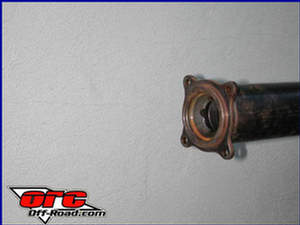 This is the stock Toyota housing end, stripped bare
and ready for assembly. The machined adapter bolts directly to the
axle housing, using the supplied hardware. The spindle will only
bolt onto the adapter in one orientation, so make sure the adapter
is indexed properly, so that the spindle can be installed with the
drain slot pointed down. This will prevent water from getting
trapped between the snout and the flange. Install the spindle onto
the adapter ring using the factory hardware. This is the stock Toyota housing end, stripped bare
and ready for assembly. The machined adapter bolts directly to the
axle housing, using the supplied hardware. The spindle will only
bolt onto the adapter in one orientation, so make sure the adapter
is indexed properly, so that the spindle can be installed with the
drain slot pointed down. This will prevent water from getting
trapped between the snout and the flange. Install the spindle onto
the adapter ring using the factory hardware.
 Next the hub
assembly slides onto the spindle. It’s advisable to install
new bearings and seals at this time. The hub fastens to the spindle
using factory hardware. We’re going to have to do some
machining to these hubs in order to use the stock Tacoma rotors
which slip OVER the hub and wheel-studs instead of using the stock
rotors that are mounted to the backside of the hub. Although this
makes for some more work up front, changing rotors will be simpler
than the OE design (the rotors are held on by two bolts and the
wheel-studs are then pressed through the rotor and hub). Next the hub
assembly slides onto the spindle. It’s advisable to install
new bearings and seals at this time. The hub fastens to the spindle
using factory hardware. We’re going to have to do some
machining to these hubs in order to use the stock Tacoma rotors
which slip OVER the hub and wheel-studs instead of using the stock
rotors that are mounted to the backside of the hub. Although this
makes for some more work up front, changing rotors will be simpler
than the OE design (the rotors are held on by two bolts and the
wheel-studs are then pressed through the rotor and hub).The axle-shaft slides inside the snout and engages the differential at the center section. The locking-hub body slides over the axle-shaft. We don’t have a picture of the locking hubs installed because we are planning to use custom drive flanges instead. FROR sells a high-strength 12-point ARP stud conversion kit for the locking hubs. Hendrix Motorsports is also capable of performing a 6-pin upgrade for added shear strength. The stock outer hub assembly only has a 2-pin interface, which has on occasion been known to shear under heavy off-road use, Hendrix machines the stock components to accept 6 pins.
CONCLUSION There are many examples of semi-floating axles that have performed well in all types of vehicles, including some that are used HARD off-road. If full-floating axles aren’t in the budget, check out the 4340 semi-floating Toyota axle-shafts from Poly Performance. If you’re interested in using the best components available to build a Toyota-based rear axle that is easy to build, install and find parts for, FROR’s full-floater kit is well-worth the money. In the next installment, we’ll fabricate and install the disc caliper mounts and new lower shock mounts. We should be ready to prep the new axle assembly for final installation.
ARB USA WFO Concepts
Diamond Axle Yota Yard |
Follow @Off-Road

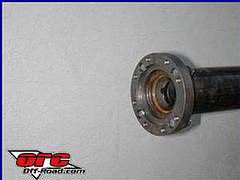
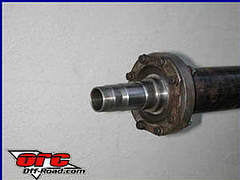
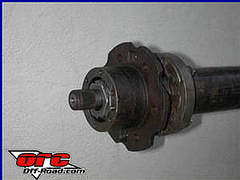
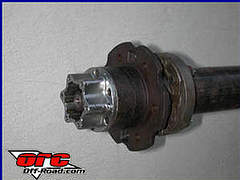

 Your Privacy Choices
Your Privacy Choices